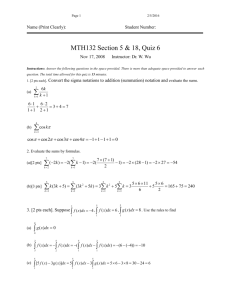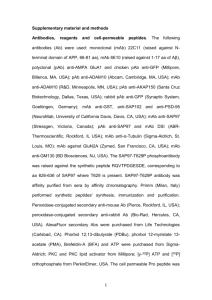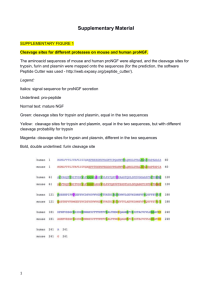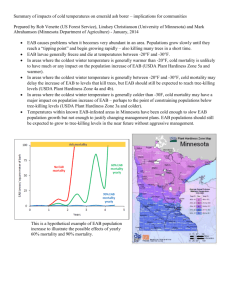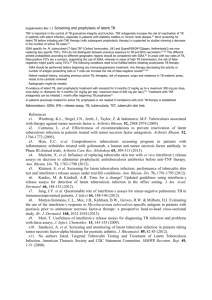final-96s
advertisement
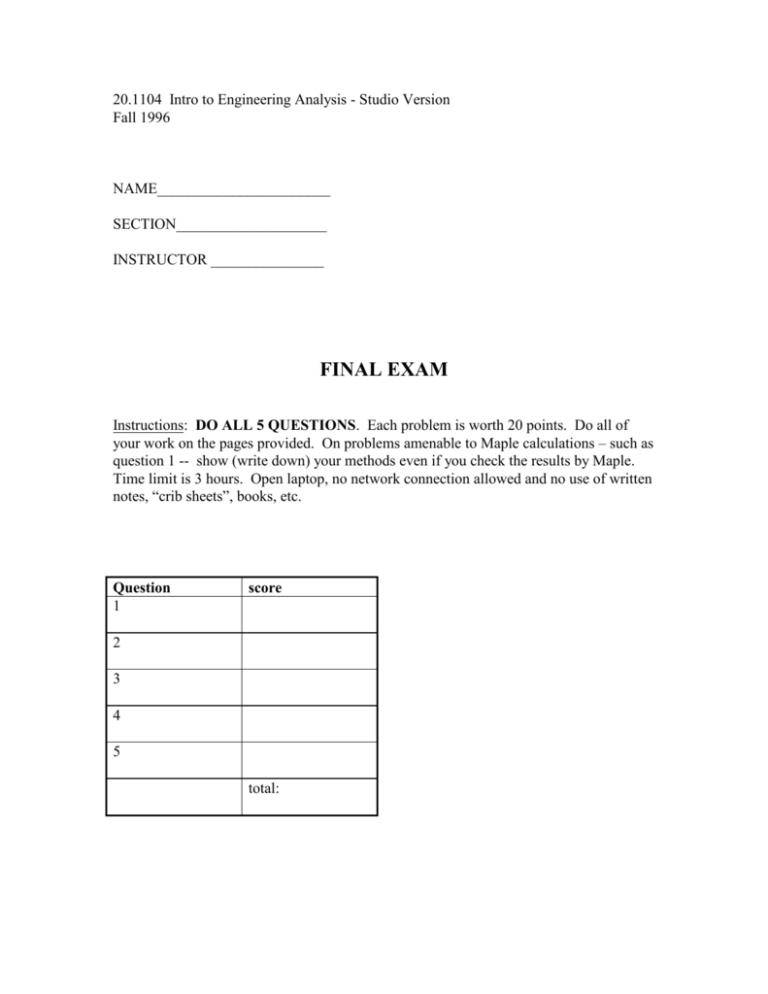
20.1104 Intro to Engineering Analysis - Studio Version
Fall 1996
NAME_______________________
SECTION____________________
INSTRUCTOR _______________
FINAL EXAM
Instructions: DO ALL 5 QUESTIONS. Each problem is worth 20 points. Do all of
your work on the pages provided. On problems amenable to Maple calculations – such as
question 1 -- show (write down) your methods even if you check the results by Maple.
Time limit is 3 hours. Open laptop, no network connection allowed and no use of written
notes, “crib sheets”, books, etc.
Question
1
score
2
3
4
5
total:
1. (20 points)
A and B are matrices, b and x are column matrices.
3 0 3
A 0 2 1
1 4 1
1 3 2
B
5 3 1
0
b 2 x
1
x1
x2
x 3
(a) (2 pts.) Calculate Bb:
0
1 3 2 1(0) 3(2) 2(1) 8
2
5 3 1
5(0) 3(2) 1(1)
7
1
(b) (5 pts.) Calculate det(A):
3 0
det
0 2
1 4
3
2
1
3
4
1
1
0
0
1
1
1 0 2
3(2 4) 3(0 2) 12
1
1 4
det(A) = 12
For the system of equations Ax = b, answer (c) through (f):
(c) (2 pts.) Determine the augmented matrix.
A
3 0 3
b 0 2 1
1 4 1
0
2
1
(d) (5 pts.) Using elementary row operations, determine the row echelon form of the augmented matrix in
part (c).
Starting with the augmented matrix (from part c):
3 0 3 0
1 0 1 0
0 2 1 2 r1(1/ 3) 0 2 1 2 r1 r3
1 4 1 1
1 4 1 1
1 0 1 0
1 0
1
0 1 1 2 4r2 r3 0 1 1/ 2
2
0 4 0 1
0 0
1 0 1 0
1 2 1 2 r 2(1/ 2)
0 4 0 1
0
1
3
(e) (4 pts.) Determine the reduced row echelon form of the augmented matrix of part (c).
Starting with the row echelon form of the augmented matrix (from part d):
1 0
1
0 1 1/ 2
2
0 0
1 0 1
0 1 0
0 0 1
1 0
0
1
1 r3(1/ 2) 0 1 1 / 2
3
1
0 0
0
1/ 4 r3 r1
3/ 2
1 0 0
0 1 0
0 0 1
0
1 r3(1/ 2) r2
3 / 2
3/ 2
1/ 4
3 / 2
(f) (2 pts.) Calculate the solution, x, for the system.
From the reduced row echelon form of the augmented matrix (found in part e), we can see that:
x1 = 3/2, x2 = 1/4 and x3 = -3/2
2. (20 points)
Figure (a) is a diagram of the bones and muscle of a person’s arm supporting a mass.
Tension in the biceps muscle holds the forearm in the horizontal position, as illustrated in
the simple mechanical model in Fig. (b). The weight of the forearm is 9 N and the mass
m = 2 kg. Determine the tension in the biceps muscle AB and determine the magnitude of
the force exerted on the upper arm by the forearm at the elbow joint C.
First, draw the FBD of the entire frame to solve for external reaction forces:
Define all forces in terms of Cartesian Components:
B = Bxi + Byj
W = -(2 kg)(9.807 m/s2)j = -19.61j N
Wf = -9j N
MB = MBk
Theory: For static equilibrium, F = 0, M = 0
FX = BX = 0
FY = BY - 9 N - 19.61 N = 0
BY = 28.61 N
MB = MB + (150 mm)(9 N) + (350 mm)(19.61 N) = 0
MB = -8213.5 N-mm
Next, draw the FBD of member BC to solve for desired forces:
Note that member AB is a two force member, and can therefore be
represented as one tension along the axis of the member with,
= tan-1(50 mm/290 mm)
= 9.78
Define all forces in terms of Cartesian Components:
B = Bxi + Byj
C = Cxi + Cyj
MB = Mbk
TAB = -TABsin(9.78)i - TABcos(9.78)j
Theory: For static equilibrium, F = 0, M = 0
FX = CX + BX - TABsin(9.78) = 0
(1)
FY = CY + BY - TABcos(9.78) = 0
(2)
MC = MB + (290 mm)(TABsin9.78) - (290 mm)(BX) = 0
49.273TAB - 8213.5 N-mm = 0
TAB = 166.69 N, and = 260.22 with respect to the positive x-axis
Substituting into equation (1) to get:
CX = TABsin(9.78)
CX = 28.31 N
Substituting into equation (2) to get:
CY = TABcos(9.78) - BY
CY = 135.66 N
To find the reaction force at C:
C = {(CX)2 + (CY)2}1/2
C = {(28.31 N)2 + (135.66 N)2}1/2
C = 138.65 N
3. (20 points)
The masses of the ladder and the person are 18 kg and 90 kg, respectively. The center of
mass of the 4-m ladder is at its midpoint (as shown). If the angle = 30, what is the
minimum coefficient of friction between the ladder and the floor necessary for the person
to climb to the top of the ladder? Neglect friction between the ladder and the vertical
wall.
.
Equilibrium equations:
Fx = 0: Ax - Bx = 0
Fy= 0: Ay - 176.58 N - 882.9 N = 0
MA= 0: Bx (3.46 m) - (176.58 N)(1 m) - (882.9 N)(2 m) = 0
From (2): Ay = 1059.5 N
From (3): Bx = 561.4 N
From (1): Ax = 561.4 N
For Impending Motion:
Ax = Ay
= Ax / Ay = (561.4 N / 1059.5 N)
= 0.53 ANSWER
4. (20 points) The following separate problems require short answers, 5 points each.
(a) The direction cosines of the centerline OA are cosx = 0.500, cosy = 0.866, and cosz
= 0. The direction cosines of the line AG are cosx = 0.707, cosy = 0.619, and cosz
= -0.342. What is the moment about OA due to the 250-N weight? Draw a sketch to
indicate the sense of the moment about the shaft OA.
By definition, the direction cosines are the scalar components of the unit vectors. Thus
the unit vectors are:
e1 = 0.50 i +0.866 j + 0 k
e2 = 0.707 i +0.619 j - 0.314 k
W = 250 j (N)
The position vector of the 250 N weight is rW = 0.600 e1 + 0.750 e2 (m)
or rW = 0.8303 i +0.9839 j - 0.2565 k (m)
The moment about OA is MOA = eOA (eOA • (rW X W ))
0.5
0.866
0
MOA = 0.8303 0.9839 0.2565 e1 = - 32.06e1
0
250
0
MOA = i -27.77 j + 0 k ( N- m )
The moment is anti parallel to the unit vector parallel to OA, with sense of the moment in
the direction of the curled fingers when the thumb of the right hand is directed oppositely
to the direction of the unit vector.
4. continued
(b) The tension in cables AB and CD is 500 N. Show that the two forces exerted by the
cables on the rectangular hatch at B and C form a couple. What is the moment
exerted on the plate by the cables?
(i)
couple - def - equal, opposite, non-colinear forces.
Tensions are same magnitude and the cables are non-colinear, therefore we
need to show that the tensions AB and CD are antiparallel.
ra/b = -3 i +2 j + 0 k m,
magnitude = 13 , ab = - 0.8321 i + 0.5547 j + 0 k
rd/c = 3 i - 2 j + 0 k m,
magnitude = 13 , dc = 0.8321 i - 0.5547 j + 0 k
(ii)
rb/c = 0 i + 0 j -3 k m,
F = 500 ab = -416 i + 277.5 j + 0 k N
i
M = rb/c X F = 0
416
j
k
0
3 = 832.5 i + 1248 j + 0 k N-m
277.5 0
4. continued
(c) The force F = 3i + 2j - k (kN). What is the moment of the couple? What is the
perpendicular distance between the lines of action of the two forces?
r = -4 i + 3 j +1 k m,
i
M = r X F = 4
3
F = 3 i + 2 j - 1 k kN
j k
3 1 = -5 i - j - 17 k kN-m
2 1
|M|=|F|*d
25 1 289 = 9 4 1 * d
d = 4.74 m
4. continued
(d) After executing a “slam dunk” shot, a basketball player (looking a little like a thin Sir
Charles Barkley?) hangs on the rim of the basket, exerting the force shown.
Determine the moment he exerts about the origin O in terms of the dimensions h and
r and the angle .
MO = r X F
r = ( h - r sin( - 90 )) i + 0 j + r cos( - 90 ) k
a
b
F = -F j
i
j k
MO = a 0 b = r cos( - 90 ) F i + 0 j + (r sin( - 90 ) - h ) F k
0 F 0
MO = - r sin( F i + 0 j - ( r cos( ) + h )F k
5. (20 points)
The plate is supported by hinges at A and B and the cable CE. The hinge at B does not
exert a force along the axis of the hinges. The plate is loaded by the force at D. The
hinges do not exert couples or moments on the plate. What is the tension in cable CE?
Hint: It is not necessary to solve for the reactions at the hinges in order to get the cable
tension.
FBD’s:
y = 4 sin(20)
y = 1.37 ft
x = 4 cos(20)
x = 3.75 ft
SOLUTION:
rC/E = - 4 i + 3.37 j + 2.25 k ft
eC/E = rC/E / | rC/E | = (-4 i + 3.37 j + 2.25 k ft)/((-4)2 + (3.37)2 + (2.25)2)
eC/E = -0.703 i + 0.592 j + 0.395 k
T = T eC/E = -0.703T i + 0.592T j + 0.395T k
F = 20 i - 60 j lb
Note: Since you don’t want any hinge reactions, easiest method to find the tension, T, is
to sum moments about the axis AB.
MAB = 0: (rA/D x F) eAB + (rA/C x T) eAB = 0
rA/D = 4 i ft
rA/C = 4 i - 1.37 j + 3.75 k
MA/F = rA/D x F
MA/T = rA/C x T
MA/F = -240 ftlb k
i
j
k
4
1.37 3.75
MA/T =
.703T .592T .395T
MA/T = -2.76 T i -4.22 T j + 1.40 T k
MAB/F = MA/F eAB
MAB/T = MA/T eAB
eAB = ( 0 i - 1.37 j + 3.75 k) / ((0)2 + (-1.37)2 + (3.75)2)1/2 = -0.343 j + 0.939 k
MAB/F
MAB/F
MAB/T
MAB/T
= (-240 ftlb k) (-0.343 j + 0.939 k)
= -225.4 ftlb
= (-2.76 T i -4.22 T j +1.40 T k) (-0.343 j + 0.939 k)
= 2.76 T ft
MAB = 0: -225.4 ftlb + 2.76 T ft = 0
T = -225.4 ftlb / 2.76 ft
T = 81.6 lb
ANSWER

